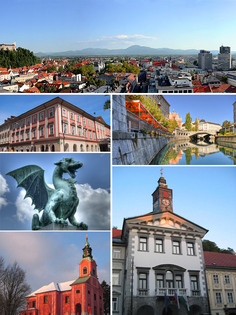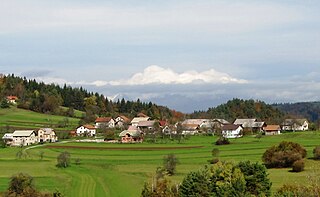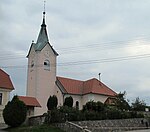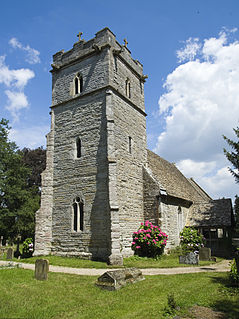
Mengeš is a settlement in the Upper Carniola region of Slovenia. It is the seat of the Municipality of Mengeš. It is located approximately fifteen kilometers from the Slovenian capital of Ljubljana. It includes the hamlets of Zavrti, Veliki Mengeš, Mali Mengeš, and Pristava.

Ivančna Gorica is a settlement and a municipality in central Slovenia. It is part of the traditional region of Lower Carniola and is now included in the Central Slovenia Statistical Region.

Moravče is a settlement in the Municipality of Moravče in central Slovenia. Traditionally the area was part of the Upper Carniola region. The village is home to about 925 people. It includes the hamlet of Trzen.

Stopiče is a village in the foothills of the Gorjanci range in the Municipality of Novo Mesto in southeastern Slovenia. The area is part of the traditional region of Lower Carniola and is now included in the Southeast Slovenia Statistical Region.

Trboje is a village in the Municipality of Šenčur in the Upper Carniola region of Slovenia. It lies east of Lake Trboje.

Zali Log is a village in the Municipality of Železniki in the Upper Carniola region of Slovenia.

Gorenja Vas is a settlement in the Poljane Sora Valley and the administrative centre of the Municipality of Gorenja Vas–Poljane in the Upper Carniola region of Slovenia. In addition to the settlement core of Gorenja Vas itself, the settlement also consists of the hamlets of Sestranska Vas north of the Poljane Sora River, and Trata and Lajše south of the settlement core.

Javorje is a village in the hills between the Selca Sora and the Poljane Sora valleys in the Municipality of Gorenja Vas–Poljane in the Upper Carniola region of Slovenia.

Gabrje is a settlement north of Dobrova in the Municipality of Dobrova–Polhov Gradec in the Upper Carniola region of Slovenia. It also comprises the hamlets of Jarčji Potok, Knapovec, Pod Kotom, Ravnik, and Žerovnik. The settlement includes three creeks—from west to east, Žerovnik Creek, Jarc Creek, and Ostrožnik Creek—all tributaries of the Gradaščica River.

Janče is a dispersed settlement in the hills south of the Sava River east of the capital Ljubljana in central Slovenia. It belongs to the City Municipality of Ljubljana. It was part of the traditional region of Lower Carniola and is now included with the rest of the municipality in the Central Slovenia Statistical Region.

Podlipoglav is a village in the City Municipality of Ljubljana in central Slovenia. The area was part of the traditional region of Lower Carniola and is now included with the rest of the municipality in the Central Slovenia Statistical Region.

Veliko Trebeljevo is a settlement in the hills east of the capital Ljubljana in central Slovenia. It belongs to the City Municipality of Ljubljana. It was part of the traditional region of Lower Carniola and is now included with the rest of the municipality in the Central Slovenia Statistical Region.

Počakovo is a small settlement in the Municipality of Radeče in eastern Slovenia. The area is part of the historical region of Lower Carniola. The municipality is now included in the Lower Sava Statistical Region; until January 2014 it was part of the Savinja Statistical Region. It includes the hamlets of Spodnje Počakovo, Zgornje Počakovo, Češence, Sveti Janez, and Jatne Kote.
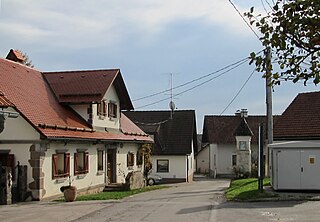
Zgornja Slivnica is a settlement in the Municipality of Grosuplje in central Slovenia. It lies in the hills north of Grosuplje and northeast of Šmarje-Sap and south of Mali Lipoglav in the historical region of Lower Carniola. The municipality is now included in the Central Slovenia Statistical Region.

Gunclje is a settlement in central Slovenia, immediately northwest of the capital Ljubljana. It belongs to the Šentvid District of the City Municipality of Ljubljana. It was part of the traditional region of Upper Carniola and is now included with the rest of the municipality in the Central Slovenia Statistical Region.

Horjul is a small town in the Inner Carniola region of Slovenia. It is the administrative center of the Municipality of Horjul. It developed from a clustered village on the north side of the marshy valley of Horjulka Creek. It includes the hamlets of Vovčne and Lipalca. Elevations in the territory of the settlement include Brezovec Hill, Rog Hill, and Lupar Hill to the north, and Rožman Peak, Kremenik Hill, and Čelc Hill to the south.

Svetli Potok is a village in the Municipality of Kočevje in southern Slovenia. The area is part of the traditional region of Lower Carniola and is now included in the Southeast Slovenia Statistical Region. It no longer has any permanent residents.

Žirovnica is a settlement in northwestern Slovenia, in the Municipality of Žirovnica. It is located in the historic Upper Carniola region, on the southern slope of the Karavanks mountain range, close to the border with Austria.

Gorenja Vas is a formerly independent settlement in the Municipality of Ribnica in southern Slovenia. It is now part of the town of Ribnica. The area is part of the traditional region of Lower Carniola and is now included in the Southeast Slovenia Statistical Region. The settlement included the hamlet of Lepovče to the east, on the other side of the railroad tracks.


